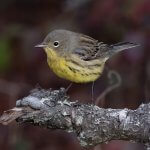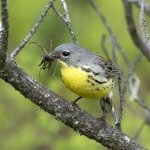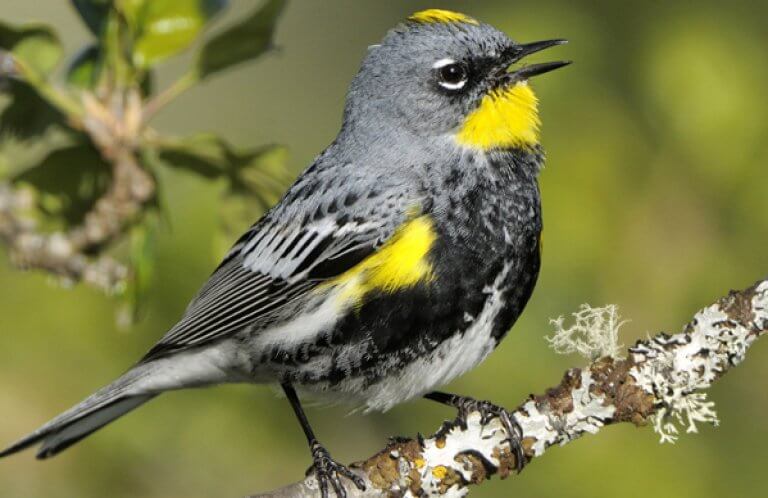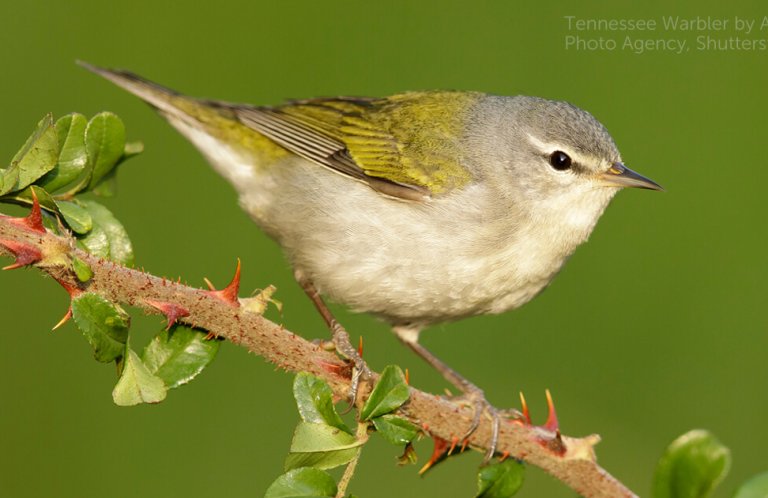About
The handsome Kirtland's Warbler is one of North America's larger warblers. At a glance, it could be mistaken for a Yellow-rumped Warbler, but it has an entirely lemon-yellow underside, a distinctive tail-bobbing habit like a Prairie Warbler, and a gray, rather than yellow, rump. This species was named for Dr. Jared Kirtland, whose Ohio farm yielded one of the first specimens of this species in 1851.
The Kirtland's Warbler is a rare sight, since it has specific habitat requirements and a very limited range. In fact, the species depends upon continued habitat management to keep its populations from dipping.
Bird of Fire
To nest successfully, the Kirtland's Warbler requires dense young stands of Jack Pine that are six to 15 years old, five to 20 feet high, and grow in very well-drained sandy soil. Scientists speculate that the age and size of the Jack Pine trees may be important in concealing the birds' nests, which are constructed on the ground. Dense ground cover, usually composed of sedges, blueberry, bearberry, and sweetfern, also helps hide nests.
This early-successional habitat favored by the Kirtland's Warbler was historically created and maintained by wildfires, but fire suppression programs reduced the amount of young Jack Pine, resulting in near-extinction of the species. It took many decades of coordinated conservation work to help bring the population to where it is now. (See “Conservation,” below.)
Songs and Sounds
On its breeding grounds, the male Kirtland's Warbler sings loudly and persistently from a prominent perch. This is the only time when this bird is easy to see. Its song is a series of three phrases, growing increasingly louder. Its call, often heard on its wintering grounds, is a sharp “chip.”
Listen here:
The Kirtland's Warbler's call:
Breeding and Feeding
Ground Nesters
Male Kirtland's Warblers return to the breeding grounds first, closely followed by females. Although each male defends a territory, it's usually close to the territories of other males, with the end result being a loose colony of these warblers.
On the ground, the female Kirtland's Warbler builds an open-cup nest of grasses, sedges, pine needles, and leaves. She lays three to six eggs, then does most of the incubating, with her mate bringing her food. The eggs hatch after about two weeks, and both parents help care for the hatchlings. The young birds grow quickly, leaving the nest only about 10 days after hatching. During this fledging period, the parents continue to care for their young until they are independent.
The Kirtland's Warbler feeds by gleaning rather slowly and deliberately through pine needles and other tree foliage, from ground to mid-canopy level. It consumes insects and their larvae, and small fruits like blueberries. Sometimes, these birds hover to snatch flying insects from the air, or to grab prey from branch tips. Like other Neotropical migrants such as the Baltimore Oriole and Tennessee Warbler, the Kirtland's Warbler consumes a considerable amount of fruit on its wintering grounds.

Region and Range
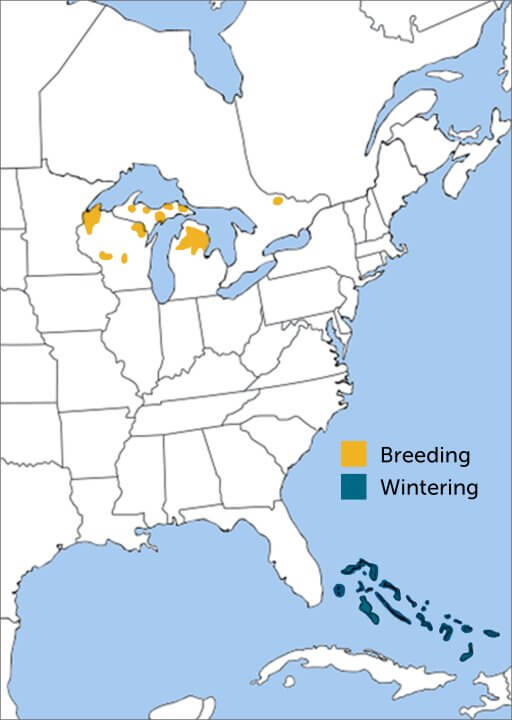
The Kirtland's Warbler has one of the smallest breeding ranges of any North American bird. Almost the entire population breeds in north-central lower Michigan, with small (but increasing) numbers in Michigan's Upper Peninsula, Wisconsin, and Ontario, Canada. This species winters in a similarly small range, in The Bahamas and the Turks and Caicos Islands, and very rarely elsewhere.
Conservation
Multi-pronged Effort for a One-of-a-kind Bird
Key threats to this uncommon bird are fire suppression and potential climate changes on the wintering grounds that could result in less suitable habitat due to drier winters and rising sea level. Poorly sited wind turbines may be a growing hazard, especially during migration.
The Kirtland's Warbler was one of the first species to be listed under the Endangered Species Act (ESA) after its passage in 1973. By 1987, the number of singing males had dropped to a low of 167. But thanks to habitat management programs that included managed burns, clear-cutting, and seeding and planting of Jack Pines — plus monitoring and control of nest-parasitizing cowbirds — the number of singing males rebounded to over 2,300 by 2015. Fortunately, cowbird nest parasitism has declined recently.
In October 2019, after 50-plus years on the endangered species list, the Kirtland's Warbler was delisted by the U.S. Fish and Wildlife Service. The population has increased five-fold since the early 1950s, far surpassing the recovery goal for the species.
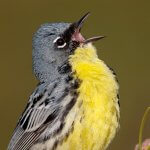
Help support ABC's conservation mission!
ABC is playing a lead role in ensuring that needed conservation efforts for the Kirtland's Warbler continue, working with a wide range of public and private U.S., Canadian, and Bahamian partners through the Kirtland's Warbler Conservation Team. The team prepared comprehensive Kirtland's Warbler conservation and business plans that address the warbler's needs across its life cycle, and that set a course for this cherished songbird's post-ESA success.
On the warbler's wintering grounds in The Bahamas, ABC and the Bahamas National Trust (BNT) have been studying the species' wintering habitat requirements, including how agriculture may play a role in creating habitat that supports fruiting shrubs that the Kirtland's Warbler depends on, especially in late winter, prior to migration. A new effort led by Antioch University New England, with ABC and BNT participation, is developing a map of wintering habitat in The Bahamas that can be used as a long-term monitoring tool to detect changes in the abundance and quality of nonbreeding habitat.
ABC also has launched a long-term fund to generate sustainable revenue for research, habitat creation and restoration, and community outreach throughout the species' range. This revenue will complement ongoing efforts by state and federal agencies to maintain the highly specific habitat the Kirtland's Warbler needs for breeding, support collaboration with Bahamian and Canadian partners, and fund outreach and educational efforts on behalf of the species. This private-public partnership represents a new model for addressing the ongoing needs of this delisted, but conservation-reliant bird species. Without ongoing management, and funding for this management, the Kirtland's Warbler would almost certainly slide back toward federally endangered status.
Get Involved
Policies enacted by the U.S. Congress and federal agencies, such as the U.S. Fish and Wildlife Service, have a huge impact on migratory birds. You can help shape these rules for the better by urging lawmakers to prioritize birds, bird habitat, and bird-friendly measures. To get started, visit ABC's Action Center.
Living a bird-friendly life can have an immediate impact on migratory birds in the United States. Doing so can be as easy as adding native plants to your garden, avoiding pesticides, and keeping cats indoors. To learn more, visit our Bird-Friendly Life page.
American Bird Conservancy and our Migratory Bird Joint Venture partners have improved conservation management on more than 8.5 million acres of U.S. bird habitat — an area larger than the state of Maryland — over the last ten years. That's not all: With the help of international partners, we've established a network of more than 100 areas of priority bird habitat across the Americas, helping to ensure that birds' needs are met during all stages of their life cycles. These are monumental undertakings, requiring the support of many, and you can help by making a gift today.






































